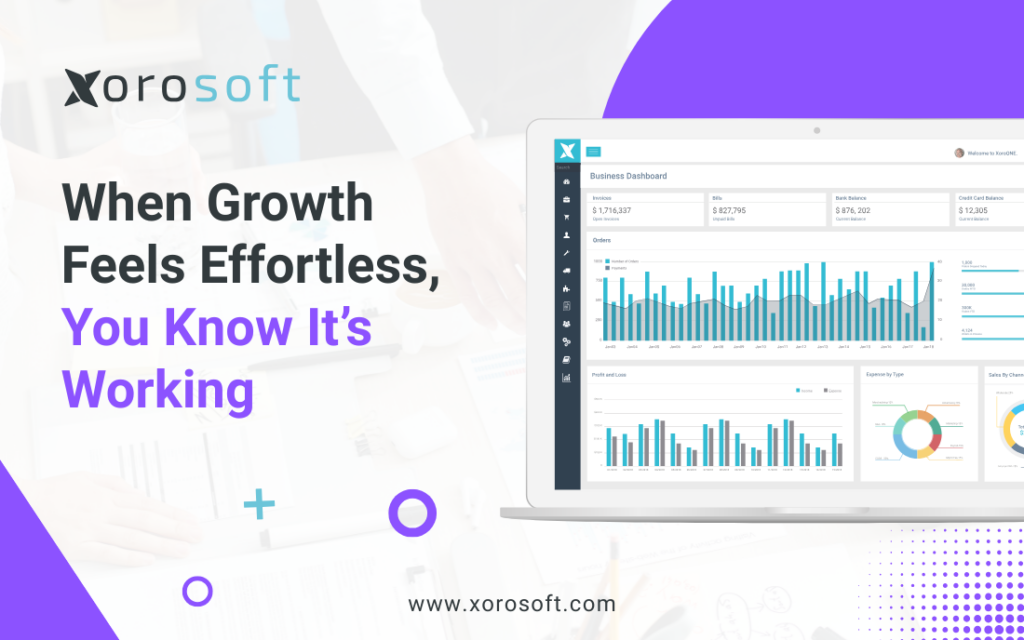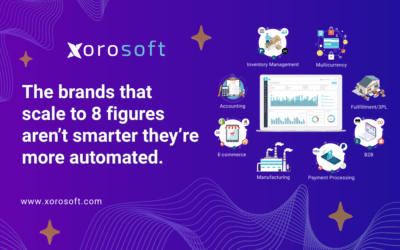
For DTC & Omnichannel Brand Leaders Who Want Operations to Run Themselves
💡 What You’ll Learn
If you’ve ever caught yourself thinking, “Growth shouldn’t feel this chaotic,” you’re not alone. Most founders eventually reach a stage where disconnected tools and siloed data turn momentum into mayhem. That’s exactly where connected inventory management becomes the difference between scaling and spiraling.
This post will, therefore, help you turn that chaos into calm.
By the end, you’ll know how to:
-
Eliminate the confusion caused by disconnected systems and manual workarounds.
-
Reclaim operational control through connected inventory management that unifies sales, inventory, and accounting in real time.
-
Improve essential metrics like pick accuracy, order cycle time, and cash conversion.
-
Apply a simple, seven-step playbook that makes your next stage of growth feel smoother — and far less stressful.
When your systems communicate effortlessly, your business finally starts to breathe again. Therefore, this guide shows exactly how to make that happen — one connected decision at a time.
Why Fast-Growing Brands Crave Effortless, Connected Operations
Every founder begins with the same goal — building a brand customers genuinely love.
However, as orders increase, so do tools, spreadsheets, and integrations. Eventually, what once felt exciting starts feeling heavy.
You want to design better products and scale channels; nevertheless, you’re pulled into reconciling reports and fixing errors. As a result, you spend more time maintaining growth than driving it.
That tension signals one truth: you don’t need more control — you need systems that move together. Once your operations align, growth starts to feel light again.
The Hidden Frictions Slowing Down Ecommerce Teams
Even strong teams struggle when systems don’t connect. These hidden issues, in fact, silently drain productivity and profit.
-
Fragmented data: Inventory sits in one app, accounting in another, and sales across several platforms.
-
Manual workarounds: Endless spreadsheets try to fix what automation should.
-
Delayed insights: Reports arrive long after the moment for action.
-
Order errors: Stockouts and duplicate SKUs slowly erode customer trust.
-
Cash-flow blind spots: You rarely know where money truly stands until the end of the week.
Each friction alone seems minor. However, together they form the drag that slows every shipment, decision, and dollar. Consequently, growth starts to resist your effort instead of responding to it.
In other words, these tiny inefficiencies quietly steal scale.
How Growth Outpaces Systems — and Why Connected Inventory Management Solves It
It’s rarely your team’s fault. In fact, most ecommerce brands simply outgrow the tools that once worked.
QuickBooks, Shopify, and spreadsheets handle early chaos. However, once you scale, those gaps widen. Every new sales channel adds another sync. Moreover, every warehouse adds a new delay.
As a result, your brand starts functioning like a software company — managing data instead of delivering value. Over time, these cracks multiply. Therefore, what was once a tech stack becomes a bottleneck.
In short, growth outpaces your systems faster than you expect.
The Shift Toward Connected Inventory Management
High-performing brands, on the other hand, stop patching and start connecting.
Instead of using seven tools to fix visibility, they consolidate everything inside a connected inventory management platform — one ERP that unifies orders, accounting, and fulfillment in real time.
When every part of your operation talks to the others:
-
You see actual margins by SKU and by channel.
-
You know precisely when to reorder and how much.
-
You detect bottlenecks before customers do.
-
You replace guesswork with predictable outcomes.
Consequently, the entire operation begins to run in sync. Growth, therefore, feels natural again — not forced.
Moreover, the team gains time to focus on strategy rather than spreadsheets.
A Real Example: Turning Operational Chaos into Calm
Consider a California lifestyle brand selling apparel through Shopify and wholesale.
Before adopting connected inventory management, they faced 12-hour monthly closes, 9% order errors, and two-week cash delays.
After implementing Xorosoft ERP, results changed dramatically. Pick accuracy rose to 98%. Real-time sync connected Shopify and warehouses. Moreover, dashboards delivered trusted data daily.
Instead of chasing mistakes, leadership started focusing on scaling new categories. Consequently, efficiency replaced exhaustion. That’s the transformation a connected system delivers — from firefighting to forward motion.
A Seven-Step Playbook to Restore Operational Ease
You don’t need an overhaul to rebuild flow. The following steps, therefore, will move your team from scattered to synchronized:
| Step | Goal → Action → Metric |
|---|---|
| 1. Locate Bottlenecks | Goal: Find where ops slow → Action: Audit order, inventory, and finance workflows → Metric: Manual steps removed |
| 2. Unify Sales Channels | Goal: Remove sync delays → Action: Connect Shopify, Amazon, and B2B into ERP → Metric: Order-processing time ↓ |
| 3. Automate Replenishment | Goal: Avoid stockouts → Action: Use demand forecasting in ERP → Metric: Stockout % ↓ |
| 4. Digitize Purchasing | Goal: Improve supplier control → Action: Create POs directly in ERP → Metric: PO accuracy ↑ |
| 5. Sync Accounting in Real Time | Goal: Shorten close cycles → Action: Integrate accounting module → Metric: Closing time ↓ |
| 6. Train for Visibility | Goal: Empower team → Action: Focus on dashboards, not data entry → Metric: Manual edits ↓ |
| 7. Measure ROI Continuously | Goal: Sustain performance → Action: Track cycle time, pick accuracy, cash conversion → Metric: Operating margin ↑ |
As you progress through these steps, every process becomes lighter. Therefore, within a few weeks, you’ll notice fewer “Where’s that order?” messages and more predictability.
Moreover, your team begins trusting the numbers again — a powerful shift.
A 30-Day Roadmap for Connected Inventory Management Implementation
Here’s a simple, reliable transition plan. Because it builds sequentially, it reduces disruption while keeping everyone aligned.
-
Days 1–3: Audit current tools and sync points.
-
Days 4–7: Connect Shopify, Amazon, and wholesale portals.
-
Days 8–10: Import inventory, SKUs, suppliers, and financial data.
-
Days 11–15: Configure purchasing, sales, and warehouse workflows.
-
Days 16–20: Run parallel testing with live orders.
-
Days 21–25: Train the team on dashboards and reporting.
-
Days 26–30: Go live and monitor order cycle time, pick accuracy, and on-time fulfillment.
As a result, this roadmap ensures a smooth, low-stress launch while building confidence across departments.
Key Performance Metrics That Prove Connection Works
When your systems sync seamlessly, the data clearly shows the payoff.
-
Pick accuracy: rises from 92% → 99%.
-
Order cycle time: drops from 2.5 days → 1.2 days.
-
Cash conversion: improves from 14 days → 4 days.
-
PO error rate: decreases 80%.
-
Inventory turnover: increases 15%.
Therefore, each gain compounds over time. Efficiency becomes a self-sustaining flywheel that powers the next stage of growth.
Common Questions About Connected Inventory Management
How soon will I see ROI after implementation?
Usually within 60 days — once inventory, accounting, and orders operate in one connected platform.
Is this only for large ecommerce brands?
Not at all. Smaller teams benefit even faster because inefficiencies shrink early.
Can I still use Shopify or QuickBooks?
Absolutely. Xorosoft ERP integrates natively with Shopify, QuickBooks, Amazon, and major 3PLs. Therefore, you gain visibility without giving up familiar tools.
Is migration complicated?
Not really. Guided onboarding and testing ensure most brands go live within four weeks. Moreover, support remains available through the process.
What Happens When Everything Finally Connects
Once operations run through connected systems, the noise fades.
You stop reacting and start planning. Then you stop building reports and start making decisions. Finally, you stop asking “what went wrong?” and start choosing “what’s next?”.
As a result, your leadership energy returns to where it belongs — growth.
That’s the moment when connected inventory management transforms effort into ease.
Ready to See Connected Inventory Management in Action?
If your brand has outgrown its patchwork of tools, now’s the time to unify.
🔗 Learn more on G2: Xorosoft ERP – Easiest to Use
🔗 Explore the Shopify App: Xorosoft ERP on Shopify
💬 Book a Demo: https://xorosoft.com/contact/
With connected inventory management, your operations move in harmony — and growth finally feels calm again.









